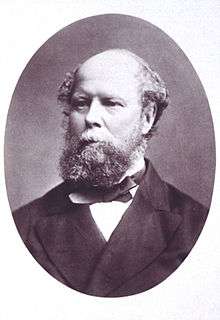William Crowther (Australian politician)
William Lodewyk Crowther FRCS (15 April 1817 – 12 April 1885) was an Australian politician, who was Premier of Tasmania from 20 December 1878 to 29 October 1879.
Dr William Crowther FRCS | |
|---|---|
 | |
| 14th Premier of Tasmania | |
| In office 20 December 1878 – 29 October 1879 | |
| Preceded by | William Giblin |
| Succeeded by | William Giblin |
| Personal details | |
| Born | William Lodewyk Crowther 15 April 1817 Haarlem, Netherlands |
| Died | 12 April 1885 (aged 67) Hobart, Tasmania, Australia |
| Spouse(s) | Sarah Victoria Marie Louise Muller |
| Profession | Surgeon |
His careers in medicine, politics, and business were overshadowed by his role in the mutilation of the body of William Lanne, the last male Aboriginal Tasmanian.[1]
Early life
Crowther was born in Haarlem, Netherlands, elder child of Dr. William Crowther[1] who was later a long-time resident surgeon of Hobart.[2] The Crowthers moved to Van Diemen's Land (now Tasmania) in 1824.
Crowther was educated at a private school at Richard B. Claiborne's Grammar School in Longford, Tasmania and then went to St Thomas' Hospital, England to study medicine. In 1842 he returned to Tasmania and practised at Hobart.
Business interests
Crowther engaged in various commercial enterprises in Tasmania. He was a shipowner, had sawmills on the Huon River and shipped lumber from Tasmania to other Australian colonies and New Zealand. He sent ships to collect guano from islands in the Coral Sea and engaged in sealing and pelagic whaling from Hobart.[3]
Political career
Crowther was elected to the Tasmanian House of Assembly in October 1866, but resigned his seat in December 1866. On 22 March 1869, he was elected to the Tasmanian Legislative Council as a representative of Hobart and held this seat until his death. He was a constant attendant and an able speaker. In July 1876 he joined the Thomas Reibey cabinet as a minister without portfolio, and on 20 December 1878 became premier. The state of the political parties at that time made it practically impossible to do anything constructive. Crowther resigned on 29 October 1879.[2]
Legacy
Crowther died in Hobart on 12 April 1885, 3 days before his 68th birthday. He was survived by his wife Victoria Marie Louise, daughter of General Muller, and their eight children. One of his sons, Dr Edward Crowther, was a member of the Tasmanian parliament from 1878 to 1912. A statue of W. L. Crowther is erected in Franklin Square, Hobart. The inscription reads:

Erected
By a grateful public,
And sincere personal friends,
To perpetuate the memory of long and
Zealous political and professional service
In this colony
By
William Lodewyk CrowtherF. R. S. C. England
The W.L. Crowther Library was named in his memory, and presented to the State Library of Tasmania by his grandson Sir William Crowther (1887–1981).
William Lanne
Crowther is noted for mutilating the remains of William Lanne, a Tasmanian Aboriginal, in 1869. He removed Lanne's skull and sent it to the Royal College of Surgeons in London.[4][5] He was suspended from his role as honorary medical officer at the Hobart General Hospital over charges of mutilating the body of William Lanney, the last male Tasmanian Aboriginal. An inquiry showed that two mutilations had taken place, the first at the Colonial Hospital, the other at the cemetery the night of the burial. Drs Crowther and G. Stokell, resident medical officer at the hospital, were suspected of the first, the Royal Society of Tasmania of the second. A petition with forty-eight pages of closely packed signatures was sent to Governor (Sir) Charles Du Cane seeking annulment of Crowther's suspension, without success.[1]
The act remained controversial in later years:[6]
A fracas occurred outside the Council chamber, Hobart Town, a few nights ago. Mr. Crowther, member for Hobart Town, threatened his colleague, Mr. Kennerley, with personal violence, because of the latter's allusion to Mr. Crowther's alleged abstraction of the last aboriginal's head. Mr. Kennerley called the attention of the House to the circumstance, and Mr. Crowther was reprimanded.
— Nelson Examiner and New Zealand Chronicle, 15 August 1873
Despite a long life involving many other endeavours and achievements in his adopted home and abroad, according to historian Helen Patricia MacDonald "the events of 1869 came to define William Crowther's place in Tasmanian history."[7]
References
- Crowther, William Edward Lodewyk Hamilton (1969). "Crowther, William Lodewyk (1817–1885)". Australian Dictionary of Biography, Volume 3. MUP. pp. 501–503. Retrieved 1 September 2007.
- Percival Serle (1949). "Crowther, William Lodewyk". Dictionary of Australian Biography. Angus & Robertson. Retrieved 1 September 2007.
- James Robinson (edited by Michael Nash) Captain Robinson; the reminiscences of a Tasmanian Master Mariner; James William Robinson, 1824-1906, Hobart, 2009, pp.1-2, 58-9 & 94-5.
- http://adb.anu.edu.au/biography/crowther-sir-william-edward-lodewyk-hamilton-12374
- Richard J. Chacon; David H. Dye (2007). The taking and displaying of human body parts as trophies by Amerindians. Springer. p. 26. ISBN 978-0-387-48300-9.
- "Tasmania". Nelson Examiner and New Zealand Chronicle. Nelson, New Zealand. 15 August 1873. p. 3.
A fracas occurred outside the Council chamber, Hobart Town, a few nights ago. Mr. Crowther, member for Hobart Town, threatened his colleague, Mr. Kennerley, with personal violence, because of the latter's allusion to Mr. Crowther's alleged abstraction of the last aboriginal's head. Mr. Kennerley called the attention of the House to the circumstance, and Mr. Crowther was reprimanded.
- MacDonald, Helen Patricia (2006). Human Remains: Dissection and Its Histories. Yale University Press. p. 177. ISBN 9780300116991.
External links
| Wikisource has original text related to this article: |
| Political offices | ||
|---|---|---|
| Preceded by William Giblin |
Premier of Tasmania 1878–1879 |
Succeeded by William Giblin |
| Tasmanian Legislative Council | ||
| Preceded by Philip Fysh |
Member for Hobart 1869–1885 Served alongside: Agnew/Smart, Wilson/McGregor |
Succeeded by William Crosby |